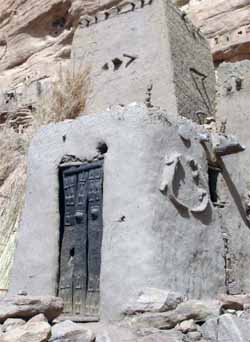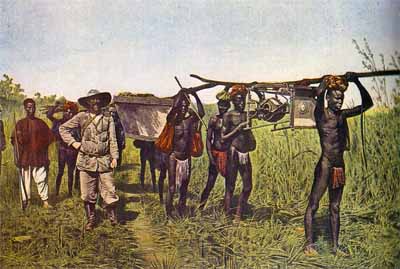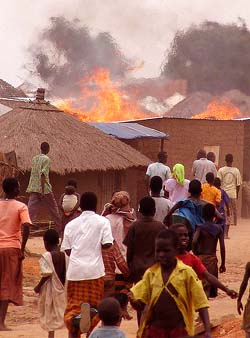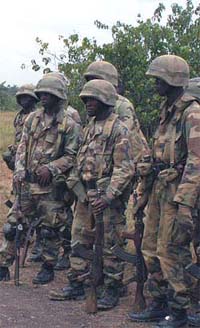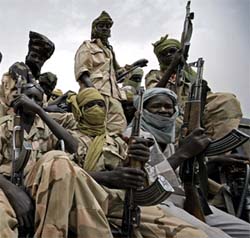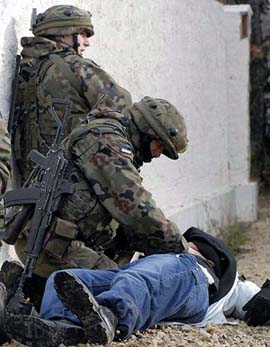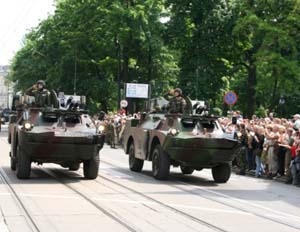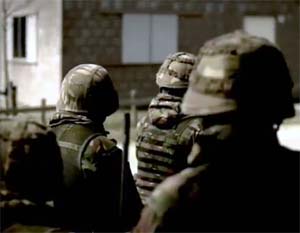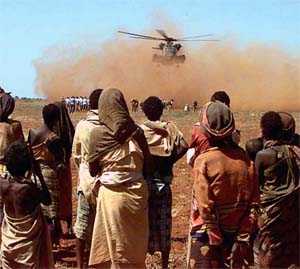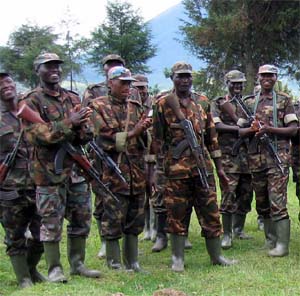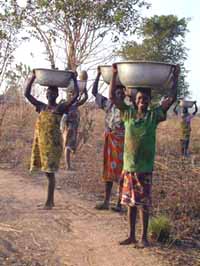  Kumanga Inhabitants: 3,042,850
Inhabitants: 3,042,850Capital: Malibe Government: presidential democracy Languages: Kumangan (Bombutu, Siba and Wahadi), French, Frilandic Religion: Islam (45%), Catholicism (20%), nature religions (30%), other (5%) Currency: Owˇ (0.0013 euro) General information The full name of the island is "Democratic Republic of Kumanga Yala". The name "Kumanga Yala" means something like "Fertile Earth", but is often abbreviated to "Kumanga". The country is an unstable democracy that is regularly threatened by extremist groups and rebels. Inflation, corruption and poverty also form a serious problem. Location Kumanga lies in West Africa, near the coast of Nigeria. 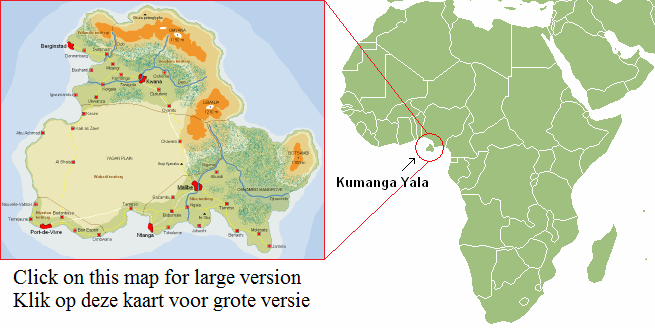 Government Kumanga is ruled by the Kitaifa Bunge ("National Parliament"), which can hardly function due to the large contrasts within the country and has only limited influence outside the capital. The country is divided into five territories, which are each ruled by their own regional parliament. These are the tribal territories of the Siba, Wahadi and Bombutu, and the Frilandic and Hiverian autonomous regions. These last two have, at least formally, a less far-reaching autonomy than the three tribal territories. In reality all five territories are virtually independent and the Kumangan national government can be regarded as a coordinating collaboration, of which some members, including the president, try to cross the ethnic, cultural and religious boundaries to unite the country under one government. Because of this, there is a continuous power struggle going on behind the scenes, in which sometimes the national government gains influence, and sometimes power shifts back towards the regional parliaments. Economy The Kumangan economy is largely dependent on oil extraction, which takes place on the Shamba Mafuta oil fields and with oil rigs at sea. The government mainly cooperates with the Hiverian oil company Raffinerie Enboneau and the Frilandic Er■olei Bidreib Raudhar (EBR). The agricultural sector performs poorly, despite the fertile soil. The underdeveloped economy is the result of poor education, widespread corruption and an unfair distribution of wealth. Population The majority of the Kumangan population consists of Africans and can be divided into three tribes: the Bombutu in the north, the Siba in the east and the Wahadi on the Yagan plain. These tribes each have their own territory in which they can have their own laws, as long as these do not conflict with the constitution. A minority is formed by Europeans: the Frilanders in a small, autonomous territory in the northwest and the Hiverians in a similar territory in the southwest. Culture On Kumanga many different cultural influences can be found: the dominant culture is that of the native Bantu population, which can be divided into Siba, Wahadi and Bombutu. These cultures are closely related and mainly distinct themselves with different religious customs. Especially Islam has much influence on Kumanga since the 15th century. Besides that, there are European influences from the Frilandic and Hiverian minorities in the country, especially Hiverian culture has left its mark on Kumanga during the colonial era. Besides many Islamic and Catholic holidays, the Kumangans celebrate Uhuru ("Freedom Day") on August 14, the day on which Kumanga became independent from Hiveria in 1961. An important characteristic of Kumangan culture are her many dancing styles. Especially the Chui Ngoma ("Leopard Dance") is popular. A typically Kumangan music style is Mbiliwimbo ("Double Song"), a mixture of traditional African music and Arabic music. Famous Kumangan artists who play this music style, are Mensur Abega and Aboubacar KundÚ. Religion The largest religion on Kumanga is Islam, especially amongst the Wahadi tribe. Catholicism, which was spread by Hiveria during the colonial period, has many followers throughout the country, especially amongst the Siba and the Hiverian minority. The native nature religions also have many followers, especially outside the big cities and amongst the Bombutu tribe. Languages The official language of Kumanga is Kumangan, which can be divided into three main dialects: Siba, Wahadi and Bombutu. French is also widely spoken, especially in the big cities. In the northwest people speak Frilandic. Kumangan belongs to the Niger-Congo language group. It's originally a Bantu language but, over the centuries, has adopted many influences from Yoruba, which is spoken in Nigeria. Police The national police is notorious for it corruption; almost everything can be bought off by putting the right sum of money in the right hand. This even goes for serious crimes like murder. Besides the national police, the Siba, Wahadi and Bombutu have their own tribal meetings, which often round up, judge and (when necessary) punish criminals, without involving the police. The Frilandic and Hiverian autonomous regions both have a regional police force and also prefer not to involve the unreliable, national police. Military The Kumangan Government Army ("Serikali ya Kumangani Jeshi") also has a corruption problem, but not as much as the national police, which is why it's regularly used for police tasks. The ground forces consist of the first brigade ("kwanza kundi"), second brigade ("pili kundi") and third brigade ("tatu kundi"), which are mainly equipped with outdated Russian weapons and material. The air force commands a modest amount of airplanes and helicopters. The navy commands thirteen small patrol ships and six big ones: the KM Olanrewaju, KM Opeyemi, KM Simisola, KM Lumusi, KM Bangoura and KM Abumoso. History of Kumanga Prehistory: The first inhabitants The discovery of flint tools near Okawesi implies that Homo Erectus was the first hominid to reach Kumanga. Back then the island was still attached to the African continent because of the low sea level, which allowed for example the African forest elephant (Loxodonta cyclotis) to reach the island from the mainland. The elephant graveyard of Iboji Ajanaku also mainly originates from this period. The first modern humans in Kumanga were Bantu people, they arrived from Nigeria and Cameroon around the 1st century AD; the petroglyphs of Okuta in the far north of the island were made by them and they were also the ancestors of the three tribes that inhabit the island today: these tribes are the Bombutu (in the north), the Siba (in the southeast) and the Wahadi (on the Yagan plain). Little is known about the history of Kumanga prior to the 15th century because nothing was written down back then. 15th century: The Olanrewaju kingdom In the 15th century a number of Arab merchants settled on the western coast of Kumanga. Not only did they bring impressive new inventions but also their belief in Islam. Many local inhabitants adopted the religion of the merchants, including a young man named Olanrewaju. Driven by religious fervour he decided to spread the faith to the rest of his tribe. He built a number of mosques and for his fellow believers he founded settlements with Arab names, examples of these are Abu Achmad and Kalil as Zawr. Although Olanrewaju was known as a holy man he also didn't avoid battle: in the year 1441 he managed to make the entire tribal territory of the Wahadi his kingdom and convert many of his people to his religion. Although his military campaigns against the Siba and the Bombutu failed, the kingdom of Olanrewaju was one of the most powerful in Kumangan history. Olanrewaju died in 1464; thereafter many years of succession struggles broke out that caused the empire to fall apart.
The Simisola kingdom At the beginning of the 16th century Opeyemi became king of the Siba tribe: under his policy the power of the Siba outgrew that of the Wahadi, who originally had the most influence in Kumanga. This eventually led to a war between both tribes. Opeyemi's son Simisola bought firearms from Portuguese merchants and raised a strong army, with which he managed to defeat the Wahadi in 1538. After a short struggle the Bombutu were also annexed by the new kingdom, which united the entire island for the first time in its history. Thereafter Simisola poisoned his father Opeyemi and became king of entire Kumanga. He made Ngala the capital and ordered thousands of slaves to build him an impressive palace: this became Ile Oba, these days one of Kumanga's largest tourist attractions. The Gold Wars After the death of Simisola in 1573, he was succeeded by his son Lumusi. Under Lumusi the kingdom experienced its peak and Kumanga was one of the most wealthy areas of West Africa. In 1590 however, gold was found in the Nigana river, which caused local chieftains to fight eachother over ownership of the river. King Lumusi asked the chieftains to remain calm and decided that the gold should benefit all Kumangans. The chieftains did not accept this and king Lumusi was killed. Without a king the country fell into chaos and several tribal chieftains tried to seize power. Most of the capital, Ngala, was laid to waste and all forms of unity ceased to exist. This period has become known as the Gold Wars, which in the end had no winners. 17th century: The arrival of the Frilanders In 1620 the Frilandic explorer Inghar Landmanssun landed in the northwest of Kumanga. The Bombutu granted him permission to found a trading post, which he named after the former queen Bergin. Because of the profitable trade contacts with the Kumangan tribes many Frilandic merchants decided to settle in Berginstad. Gold seekers and adventurers also felt attracted to the far, mysterious island. Eventually there were so many of them, that it was decided to purchase the piece of land between Berginstad and the Od˛ river from the Bombutu and build the settlements of Dannanburg and Sun■haim there. This resulted in a small, Frilandic part of Kumanga west of the Od˛, that never formally became part of Friland but instead functioned as a self-governing dwarf state, albeit within the Frilandic sphere of influence. Hiverian colony Some years later the Hiverians also landed on Kumanga. Because a large part of the African west coast already laid within the Portuguese sphere of influence, it was decided to found a colony on Kumanga. In 1634 the Wahadi gave Hiveria their permission to build a trading post at the southeast coast of the island. The Hiverian "trading post" however, had little in common with the Frilandic one to the north: it was surrounded with a heavy wall and equipped with cannons and a military garrison. The Hiverians called the fortress "Port-de-Vivre". The Wahadi protested because the building of a fortress was not agreed upon, but the Hiverians gave them mirrors and beads and assured them that the fortress only served as a protection against pirates. The Kumangans, who were poor and divided since the Gold Wars, could do nothing against it. Not long thereafter the Hiverians founded new settlements; the most important ones were Terrejaune, Nouvelle-Valtrois and Bon Espoir. The Wahadi villages of Badanbasa and Ombwana were also annexed into the new colony. Missionaries tried to convert the Kumangans and in many places they managed to replace Islam and the native nature religions by Christianity. The Tax Rebellion The last straw was the fact that Hiveria started collecting taxes in the lands of the Wahadi and the Siba, implicating that these fell under their rule. Because of this the two tribes, which were actually eachother's rivals, formed an alliance and collectively marched to Port-de-Vivre. Ombwana and Bon Espoir were plundered but the rebels did not succeed in taking the fortress. Hiveria then brought in reinforcements and expelled the Kumangan warriors from the colony. Hereafter they used their military overweight to bring most of Kumanga under their control. In 1661 Hiveria declared all of Kumanga her protectorate, which in fact brought the whole island under her rule. However; in the north, where the tribal territory of the Bombutu and the Frilandic trade posts were located, Hiveria didn't get much influence. 18th century: Slavery Due to the large demand from America, people were delivered from all corners of Kumanga to be sold as slaves. In most cases they were abducted by rival tribes and then resold on the slave market of Port-de-Vivre. At the harbour they were then shipped to America; one tenth of them did not survive the passage. These practices would continue until the end of the 19th century. Power change In 1794 the Hiverian revolution broke out, in which king Charles Concarneau was killed. Governor Raoul Joubert, a descendant of the famous general Ancel Joubert, remained loyal to the monarchy and refused to turn over the colony to the revolutionary government. A few months later the new Hiverian regime sent an army to Kumanga, which was defeated at Nouvelle-Valtrois by the colonial troops of governor Joubert. A second attempt also failed, which caused the new regime to seriously lose face. Only when Raoul Joubert died of malaria the year thereafter, the Hiverian colonial army decided to cease the struggle and turn over the colony to the Revolutionary Council.
19th century: Fourth Frilandic-Hiverian War In 1881 the Fourth Frilandic-Hiverian War broke out. For the Hiverian rulers this was a chance to take the Frilandic protectorate in the north of the island, which had been a moot point between both countries for two centuries. On May 15 the Hiverian colonial army crossed the Od˛ and occupied Sun■haim. Because Friland had no army on Kumanga, the only defence force consisted of militia that was hastily drafted from civilians with hunting weapons, also called "fulkshar" (people's army or civil militia) in Friland. The Fulkshar decided to retreat to Berginstad, after which the Hiverian army easily conquered Dannanburg and marched into Berginstad. However, in the narrow city streets they were at a severe disadvantage; the Fulkshar had laid ambushes and in heavy street fighting the Hiverians suffered so many losses that they had no other option but to pull out. The battle of Mbangi After their retreat over the Od˛, the Hiverians decided to set up camp near Mbangi and wait there for reinforcements from the Siba, Wahadi and Bombutu. Because they were in the land of the Bombutu, these arrived first. Many Bombutu however, had sympathy for the Frilanders, with whom they had a better relationship than with the colonial administration. One day after the arrival of the reinforcements, a new group of Bombutu warriors appeared: these however, were hostile towards the Hiverian army. South of Mbangi these two hosts clashed, in which the Frilanders came to the aid of their allies and the Hiverian army was surrounded. A mass carnage broke out and only a small portion of the Hiverian army managed to escape by fleeing into the jungle. The aftermath The defeat at Mbangi was proof to the Kumangans that even a modern, European army could be beaten. In many places in Kumanga a rebellion broke out, which started to pose a second threat to the Hiverians beside the Fulkshar and its Bombutu allies. To the colonial administration the end of the war therefore came as a relief, because this made the Frilanders and the Bombutu cease their hostilities and allowed the administration to aim its full attention at the rebellion. It would still take until 1883 before order in the colony was restored. 20th century: Colonialism and world wars At the beginning of the 20th century many European powers tried to increase their might in Africa. Hiveria also made an attempt to annex what is now Nigeria, but eventually had to leave it to Great Britain. The First and Second World War had little influence in Kumanga, although in the First World War during the allied invasions of German Togo and Cameroon four Hiverian ships were mistakenly torpedoed. Kumanga independent After the Second World War protests against the colonial rule broke out in Kumanga. Hiveria, which had learned from the massacre of BahÝa del Palma, therefore decided to give up the colony: on August 14, 1961 president Lejeune granted Kumanga its independence. With this, governor Sylvain Prideux officially relinquished control to Temitope Bangoura, the newly chosen head of state. The Hiverian colonial army was disbanded; only in the southwest a battalion of the Garde d'Acier remained temporarily stationed in order to protect the Hiverian civilians there during the turbulent transfer period. This largely Hiverian area became an autonomous region of the new, independent Kumanga, in which the tribal lands of the Bombutu, Siba and Wahadi were also given a limited form of autonomy. Frilandic Kumanga also autonomous region After this, the newly independent country of Kumanga demanded that the Frilandic dwarf state in the northwest would also join her. The Frilandic Kumangans refused this and turned to Friland for support. Although Frilandic Kumanga did not officially belong to her territory, Friland did regard it as her protectorate and came with a proposition in which Frilandic Kumanga could remain an independent state and there would only be economic cooperation with the new Kumanga. This was refused an after strong international pressure Friland subsided the proposition to a solution that all parties eventually agreed with: on September 5, 1961 Frilandic Kumanga abandoned its independence and became an autonomous region within the new republic of Kumanga, on the condition that the Frilandic identity of the area would remain intact. Failed coup d'Útat by Atangana On September 28, 1961 the government building in the capital, Port-de-Vivre, was suddenly attacked by rebels of Efunsegun Atangana, a warlord from Okawesi who believed he should have become president instead of his rival Temitope Bangoura. A Hiverian helicopter managed to bring president Bangoura to safety while the Kumangan government army ended the siege of the government building with help of the Hiverian Garde d'Acier. Atangana then started conducting a guerrilla, which lasted until his death in October 1962. The Ogunti President Temitope Bangoura, a member of the Wahadi tribe, remained unpopular amongst the Siba and the Bombutu. Some of them therefore joined the Ogunti, a radical organisation that wanted to seize control in Kumanga. At first the Ogunti only performed small-scale attacks but in 1968 their raids became more professional and they started to arm themselves with heavier equipment that they secretly bought from the Soviet Union. The support for the Ogunti was especially large in the north and east of Kumanga, where president Bangoura had little influence. First Kumangan Civil War On March 30, 1969 the Ogunti started a major attack on Ntanga in which they used, amongst others, MiG-19 jets and T-54 tanks. The Kumangan government army, which had seriously underestimated the strength and equipment of the Ogunti, was driven back and lost the city. In the months thereafter the Ogunti gained control over the tribal territories of the Bombutu, the Siba and the eastern part of the Wahadi territory. After heavy fighting the Frilandic autonomous region surrendered on the condition that she would be allowed to retain her autonomous status, which the Ogunti accepted, also because this prevented a possible intervention of the Frilandic motherland. Only the southwestern part of Kumanga was still in the hands of the Kumangan government. President Bangoura decided to ask Hiveria for help, which sent troops to aid the government army. A counteroffensive followed and in the north the Ogunti were driven back to the Taragola river and in the east to Ntanga, which remained in Ogunti hands despite many days of struggle. 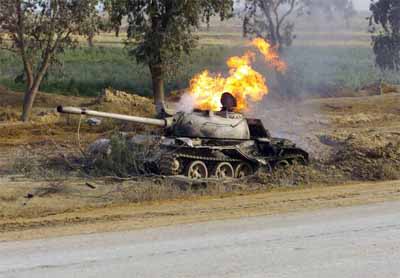 Destroyed tank of the Kumangan government army In February 1970 the Ogunti attacked the city of Tameso, in which a large portion of the Hiverian army and the Kumangan government army got stuck between Ntanga and Tameso. Ogunti MiG's prevented air support and an evacuation by sea, thereby trapping the government army. This then attacked Tameso to enforce a breakthrough westwards, but didn't succeed in this and was forced to surrender. Due to the defeat at Tameso the war was practically decided: the government forces in the east were defeated and those up north were forced to pull back and relinquish the entire Yagan plain. The road to the capital was now wide open. The defeat The Ogunti marched into the southeastern part of Kumanga and committed many atrocities to the Hiverian population, whom they associated with the former colonial oppression. Many Hiverians therefore left the country or fled further westwards. What remained of the Hiverian army left Kumanga in disarray, in which they tried to take with them as many Kumangan allies and Hiverian citizens as they could. The oil reserve in Terrejaune was set ablaze and the materiel that didn't fit onto the ships, was dumped in the sea so that it couldn't fall in Ogunti hands. The fall of Port-de-Vivre In the meantime, the capital had changed into a fortress that was surrounded by the Ogunti from all sides. From Nigeria Hiverian airplanes maintained an airlift: the Rue de Bottier, a long, broad street near the railway station of Port-de-Vivre, thereby served as a landing strip. By these means a large number of people could still be brought to safety and were granted political asylum in Hiveria. President Bangoura and the full council of ministers also escaped this way. On April 3, 1970 the Ogunti started their attack on the city, in which the handful of government troops that hadn't deserted yet were easily defeated. At 2:45 PM the Ogunti flag was raised on the roof of the government building: Port-de-Vivre had fallen. Dictatorship and famine The Ogunti victory was followed by hundreds of political murders, they also chopped of the right hand of everybody who had worked for president Bangoura. General Kantigi Coulibaly proclaimed himself the new president of Kumanga; on important positions he appointed Ogunti members and he moved the capital to Malibe, which it still is today. However, general Coulibaly, who managed to keep his power for a long time, did nothing to restore the economy. In 1987 a famine broke out that claimed hundreds of thousands of lives in Kumanga. The food aid that the international community sent, was sold by general Coulibaly and with the money he built two palaces, a shopping mall for rich tourists and a golden statue for himself. 21st century: Democracy When general Coulibaly died in 2001, Kumanga breathed a sigh of relief. Pressured by the UN the Ogunti decided to write out elections, which they lost. When they tried to fraud with the outcome the army, which had turned away from the Ogunti, decided to intervene. Three generals conducted a peaceful coup and then handed over power to the democratically chosen government of the new president Kolapo Abumoso. The Kumangan democracy however, is far from stable and is since then being severely tested by Ogunti rebels and radical Muslims of the Olodumare militias, who both cause a lot of unrest. Failed coup d'Útat by Olodumare militias On December 14, 2008, radical Islamic Olodumare militias committed a coup d'etat, in which multiple bomb attacks were performed and the cities of Bazambu, Bobomale and Tabalume were occupied. The capital, Malibe, was besieged, but could be saved by the Kumangan government army. Because of this, the coup failed and the Olodumare went back to their original guerilla tactics. Since then, they remain a constant danger, especially in the Wahadi tribal territory. Second Kumangan Civil War In February 2013 the Ogunti undertook another attempt to seize power, this time led by Sani Coulibaly, the grandson of the dictator that died in 2001. In a short time they occupied the entire Bombutu tribal territory and dealt a heavy blow to the government army at Kwana. After that, fights also broke out in the Siba tribal territory between Ogunti supporters and government troops, even in front of president Mabuwasi's palace in the capital city of Malibe.
Defeat at Mbangi Due to the occupation of the Bombutu tribal territory, the Frilandic autonomous region was cut off from the free part of Kumanga. Because the government army in the north had been severely weakened, the defence of this small region rested almost completely upon its private militia troops, the Frilandic Kumangan Land Guard (FKL). Units of these joined the remains of the government army in Mbangi, a Bombutu city near the Od˛ river, to halt the Ogunti offensive there. On March 21, after three days of heavy fighting, Mbangi eventually fell to the Ogunti, who vastly outnumbered the defenders. During this, they created a bloodbath among citizens as well as captured FKL- and government troops. The defeat at Mbangi not only meant the total annihilation of all government forces in northern Kumanga, but also a severe blow to the FKL, who were forced into a defensive position after this and had to retreat behind the Od˛. The Sun■haim massacre Positioned directly at the Od˛ was the strategic city of Sun■haim, the gateway to Frilandic Kumanga. Here several days of struggle took place between Ogunti rebels and hastily gathered, poorly equipped FKL militias. After a grim, but uneven battle, all FKL units in the city were annihilated and on March 26 Sun■haim fell to the Ogunti. These subjected the city to gruesome carnage and plunder. Because of this, Sun■haim lost a large part of its citizens and the entire southeast of the Frilandic autonomous region was occupied. Frilandic Kumanga on the brink of collapse After this, the FKL entrenched itself in fort Storfasten at the Rauda Flaut, but after heavy fighting this position too proved to be untenable. On March 31 it therefore retreated behind the Runbak Line, a row of fortifications along the river of the same name. Part of this line was the strategic city of Dannanburg, which had to endure countless Ogunti offensives. Despite heavy losses, the FKL tried to stand ground here at all costs, because for the Ogunti the fall of Dannanburg would open the way to Berginstad, the capital of the Frilandic autonomous region. If that would happen, it would be the end of Frilandic Kumanga.
Critical situation In the rest of Kumanga the situation was just as grave: by that time half of the country had been run underfoot by the Ogunti and in the Wahadi tribal territory radical Islamic Olodumare militias seized the opportunity to take over the area. The only factions still loyal to the democratically elected government of president Kwame Mabuwasi, were the southern part of the Siba tribal territory, the Frilandic and Hiverian autonomous regions and the remains of the government army, which managed to hold out with great effort on the south coast and in the area around the capital. The president therefore made a desperate appeal to the United Nations for a military intervention. However, because of mutual disagreement his plea for help remained unanswered. Frilandic help To prevent the destruction of Frilandic Kumanga, the Frilandic motherland decided to offer secret help. However, because she did not have the necessary UN mandate for this, she kept denying this. In the port of Berginstad Frilandic ships arrived with food, medicines, petrol, ammunition, weapons and even a number of outdated armoured cars, tanks and helicopters of Russian origin. Apart from that a few hundred 'volunteers' arrived, who were in reality servicemen of the Frilandic Rikshar to strengthen the FKL and reform it into a professional military force. Partially because of this, the Runbak Line managed to hold out and the battle of Dannanburg was won by the FKL on April 3. FKL counteroffensive Due to their crushing defeat at Dannanburg, the Ogunti were weakened and the FKL started a counteroffensive. Because of her better training, weapons and equipment, she managed to liberate all of Ogunti-occupied Frilandic Kumanga within a few days. Especially strong, newly formed units like the Laujanferhaup ("Lion Battalion") and the Nashurnferhaup ("Rhino Battalion") played an important role in this. On April 8 the river Od˛ was reached and the border city of Sun■haim was liberated. Here the FKL discovered a mass grave, containing hundreds of bodies belonging to Frilandic Kumangans and Bombutu refugees.
The battle of Kwana The FKL did not stop at the Od˛, but pushed on towards the Taragola and liberated a large part of the Bombutu tribal territory. The Ogunti regrouped at Kwana, where very heavy fights broke out when the FKL came to besiege the city. During these, both sides took no prisoners and were after eachothers total destruction. During the battle, the Ogunti fielded more than twice as many troops as the FKL. Nevertheless, the better equipped FKL managed to defeat the Ogunti and liberated the city on April 15. With the horrors of Sun■haim still fresh in mind, the FKL allowed not a single Ogunti to escape alive. American air support On the same day the United States, who absolutely didn't want the anti-Western Ogunti and the radically Islamic Olodumare to be in charge of Kumanga, received a mandate from the UN Security Council for giving emergency relief and conducting air strikes on the rebels. These attacks started on April 20 and inflicted heavy losses upon the Ogunti and Olodumare. Because of this, the FKL and the Kumangan government army could liberate large parts of Kumanga within a couple of days. The decisive blow followed on April 25: Sani Coulibaly, the leader of the Ogunti rebels, was killed in an American air strike near the city of Abundi. Return to the situation before the war Coulibaly was succeeded by Mwene Kilongo, who retreated into the jungle and returned to the guerilla tactics from before the war. The Olodumare followed this example. On April 27 at 7:15 AM, FKL militias from the north and government troops from the south met eachother near Okawesi, liberating all of Kumanga. This ended the Second Kumangan Civil War, even though the Ogunti and Olodumare, like before the war, remained an invisible threat in large parts of the country.
Places in Kumanga Most place names are in the Bombutu, Siba or Wahadi dialects of the Kumangan language. The Arab place names date from the Olanrewaju kingdom (15th century) and French and Frilandic place names from the time of the Hiverian and Frilandic presence on the island.
Abundi Al Shala Badanbasa Bazambu Benashi Berginstad (Kumangan name: Ilubergi) Bobomale Bon Espoir (Kumangan name: Banakisi) Bushanti Dannanburg (Kumangan name: Atokigi) Djalubwe Igwumambu Jabushi Jamela Kalil as Zawr Kasim Koigala Komongo Kwana Malibe Mbangi Molebata Ngala: in the 16th century this was the capital of the Simisola kingdom Nouvelle-Valtrois (Kumangan name: Mboulowa) Ntanga Okawesi Ombwana Oshome Ovandu Port-de-Vivre (Kumangan name: Kwilabango): the former capital of Kumanga Sun■haim (Kumangan name: IlÚgusu) Tabalume Tameso Terrejaune (Kumangan name: Kumala) Ukwanza Terrain Mountains Botsambi (1100 meters) Libanja (1210 meters) Umyana (1150 meters) Rivers Benu Djouvindo Nigana Od˛ Taragola Other Oshambo mangrove Yagan plain Special places Iboji Ajanaku: large elephant graveyard on the eastern Yagan plain. Ile Oba: the palace of king Simisola from the 16th century. Okuta petroglyphs: rock drawings from the first inhabitants of Kumanga.  |
